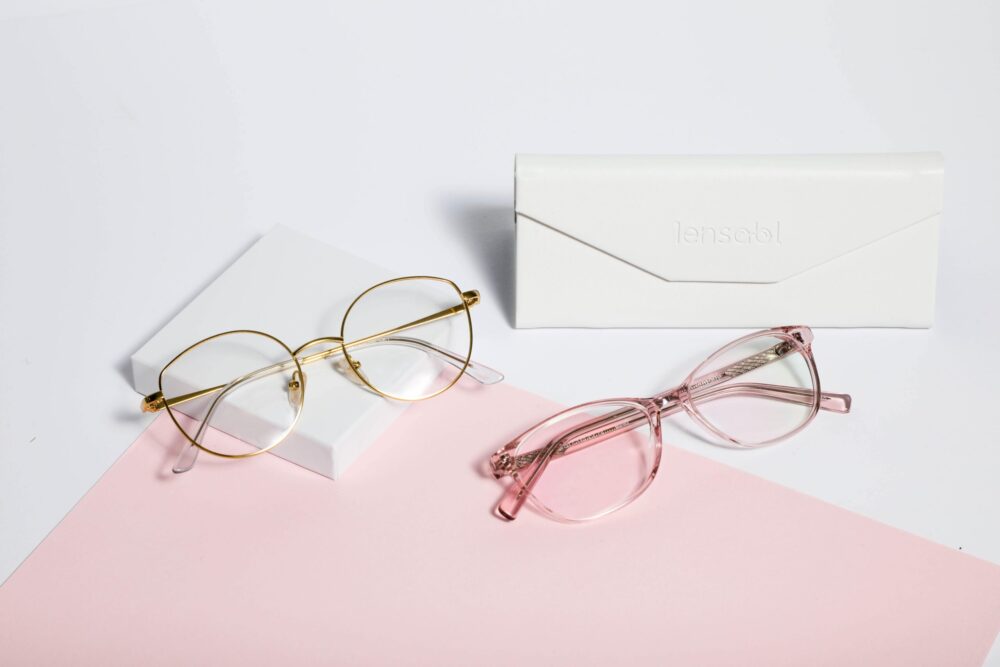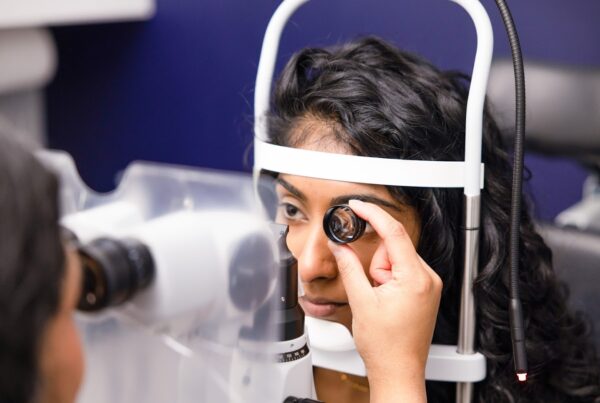
Frame selection of a metal and plastic frame
Written by: Rebecca Patterson, CCOA
Eyeglass frames come in a variety of styles, sizes, and materials. Although style and look are very important aspects of the frame selection process, the material the patient prefers can also impact the available options. Each material has its own advantages and disadvantages.
Plastics
When it comes to plastic frames, there are two main types: acetates and injected plastics. The most popular frames are acetates, which can be made into fun colours and patterns. Acetates are lightweight and fairly durable. They are quite mouldable, which makes them easy to adjust. They are often hand-assembled and hypoallergenic. Overtime, the colours can fade but you can easily minimize that with proper care.
Injected plastics are cheaper, often machine made, and quickly assembled. They are also available in a variety of different colours and patterns. This is great as a low-cost option; however they tend to be much more fragile and prone to warping or fading in the sun.
Advantages and Disadvantages of Plastics
Plastics tend to be fairly durable, come in a large variety of colours and patterns, and can be a little more cost effective than metal frames. This is a great option for people with higher prescriptions, as the frame can have thicker sides to hide thicker lenses.
One of the main drawbacks to a plastic frame is that it is harder to find a perfect fit, since we can only adjust temples. This is great for fitting the ears for a snug fit. The issue stands in the fit of the nose. Generally, plastic frames should make contact with the top and sides of the nose comfortably. However, it is possible to have different bridge styles and additional nose pads to make the fitting process easier.
Metals
Frames can come in a few different types of metlas. The most popular are monel, stainless steel, and titanium. Speciality materials include flexon and carbon fibre.
Monel is any broad mixture of metals. It can be a good, low cost option. Monel is fairly malleable and quite good at resisting corrosion. One of the major downsides of monel is that it may not be hypoallergenic and could cause skin issues with those who experience nickel allergies.
Stainless steel is a great option as it is lightweight, durable, corrosion resistant, and very affordable. Most stainless steel frames are also hypoallergenic. This makes it a very popular metal for more plain metal frames.
Titanium is the material of choice for those who require the lightest frame with the most durability. It is an excellent choice for those with sensitive skin as it is completely hypoallergenic. The light weight of the material can also help to avoid skin tugging and discomfort caused by nose pads. Next time you’re in an optical for frame selection, try on a titanium frame to feel how light it can be on your face.
Flexon is a titanium alloy that allows for near 360 degree flexibility. This is especially handy for those who are rougher on their frames, tend to put their glasses in their pocket, or those with small children who may grab at parents’ frames.
Carbon fibre is a special material that is only typically used on the temples of plastic frames. This material is extremely durable for everyday use. It is very good at holding its shape, however, it does not respond well to heat or adjustments and could snap while being bent.
Advantages and Disadvantages of Metal
Metal frames are easier to manipulate so we can make many small micr0-adjustments to your frame. We can move the nose pads to ensure a perfectly flat contact with the side of your nose. Most metal frames can also be easily adjusted at the temples. Metals also tend to be more durable than their plastic counterparts.
In some cases, those with nickel allergies are not aware or advised on the wrong material and this could lead to an allergic reaction. Metal frames are not corrosion proof, so the material can wear down and cause rusting or green corrosion. Some people also do not prefer nose pads, as they can leave marks on the nose or tug at delicate skin. Metals also tend to be a little bit more expensive than plastic frames.
Specialty
Other than metals and plastics, we can consider some other special materials. Although rare offerings, it is possible to get frames that are made with bone, horn, or wood. These are often custom made, one of a kind, and cannot be found in typical optical stores. People may want these for their rare and unique beauty. However, they are often stiff, making them impossible to adjust, and very expensive. Fortunately, you can find some plastic frames that can look like horn or wood.
When considering frame choice, one must also consider how the frames fit on the face. Plastic frames can have a saddle bridge, which sits comfortably over the top and sides of the nose like a saddle on a horse. There are exceptions to this rule which are outlined below.
Nose Fitting
Metal frames usually come with nose pads, and if needed, we can insert nose pads into plastic frames. Nose pads allow for flexibility and a much more custom fit. The two main drawbacks to nose pads are that they can become dirty fairly quickly, requiring replacement, and that they can potentially break off with too much manipulation. They can also potentially leave marks on the skin, tug at delicate skin, or be uncomfortable for some.
The other main exception to note would be a keyhole bridge. These can be a great alternative to nose pads on a plastic frame as it eliminates the need for the frame to sit perfectly on the top of the nose, and instead only uses the sides of the nose for support. The only drawback to this style is that they tend to sit lower on the face and may not look the best on everybody for that reason. This is why it’s important to have experienced optical personnel assist you with frame selection.
The last exception is a hybrid of sorts between the saddle bridge and nose pads. A comfort bridge combines the comfort of the saddle bridge with the adjustability of the nose pads. After some time, we can change the bridge out for you so that it remains comfortable, especially for those with delicate skin. It also does allow for more adjustability all around.
Conclusion
Overall, there are many different frame combinations. Personal preference and proper fitting play a unique role in deciding what is right for each person. It’s a good idea to try many different styles and materials in the frame selection phase to determine what is the right combination for you! Don’t be afraid to ask the optician or optometric assistant for their opinion on your frame and always get their opinions during the frame selection process. Read our article on frame shapes for different face shapes here.










Recent Comments